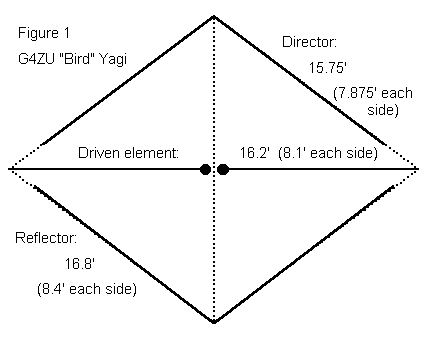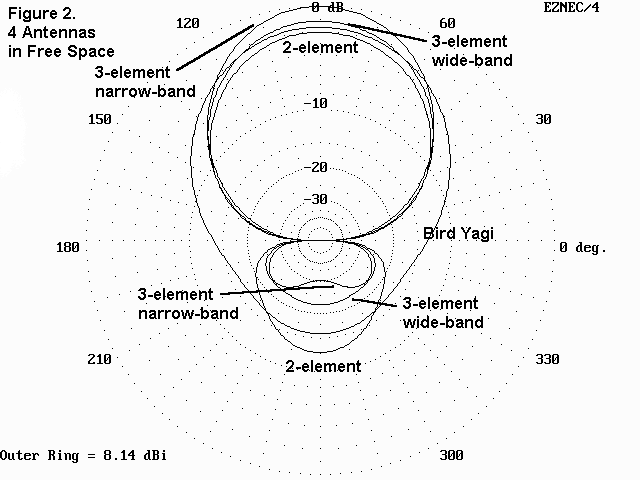 The G4ZU Bird Yagi
The G4ZU Bird Yagi
The antenna uses an interesting structure: lightweight fiberglass (or similar) tubes supporting a wire structure of elements. As shown in Figure 1, the director and reflector are bent toward the ends of the driven element, giving the antenna a hint of Moxon rectangle phenomena: parasitically induced currents plus element end coupling. Dimensions are shown for 10 meters. The only difference in my free space model and G4ZU's recommendations is a slight reduction in driven element length.

The antenna is easy enough to build. In fact, it recommends itself for Field Day type activities, since we can build it, tear it down, and reassemble the antenna at the site with minimal difficulty.
The dotted lines represent rope strung around the perimeter of the side-to- side and front-to-back supports. Wire can then simply be taped to the rope. Note that this antenna is over 16' side-to-side and 12' front-to- back.
How does the antenna play? To even the playing field, I modeled the Bird Yagi and 3 others: a simple 2-element Yagi, a wide-band Yagi, and a narrow-band Yagi. The Bird, the 2-el., and the 3-el. WB models all have feedpoint impedances close to 50 ohms and can be fed across at least the first MHz of 10 meters directly with coax (choke "balun" recommended). The narrow-band 3-element Yagi has a resonant feedpoint impedance close to 20 ohms and would require a beta match or similar. All the antennas use aluminum tubing except the Bird, which uses #12 copper wire.
All the antennas were modeled in free space. The differences in performance will reappear at virtually any antenna height from about 20' on up at 10 meters (5/8 wl or higher). For low heights, of course, driven element adjustment will be needed for all models. Figure 2 overlays the free space azimuth patterns.

First, find the Bird Yagi in Figure 2's maze of lines. Note that the pattern differs significantly from both the standard Yagi patterns and the Moxon pattern. The Yagi shows excellent side rejection, while the Bird is down only about 11 dB off the sides. (This could be either an advantage or a disadvantage for a Field Day operation, depending on the ease of beam turning, etc.) The Moxon pattern, not shown here, is a large cardioid pattern that takes in the entire forward region, but shuts down completely in the rear. The Bird Yagi front-to-rear ratio ranges from 11 dB to a peak of over 14 dB across the band. (Again, for some kinds of operations, such as area nets, this can be an advantage, since the existence of a station to the rear will be evident, if reduced. However, for other operations, more front-to-back is desirable.)
The gain of the Bird Yagi is not high as 3-element Yagis go: about 6.5 dBi in free space. This is less than 0.5 dB greater than the 2-element Yagi, although the wide-band, direct coax feed 2-element antenna has a fairly low front-to-back ratio.
The wide-band 3-element Yagi, which substitutes direct coax feed and a wide SWR bandwidth for gain, still manages an extra half dB gain over the Bird. In addition, the wide-band Yagi exceeds 19 dB front-to-back ratio across the first MHz of 10 meters. (Details on this antenna will appear in a forthcoming installment of An-Ten-Ten-nas.)
The narrow-band 3-element Yagi is optimized for gain and front-to-back ratio, although the model shown does not retain these numbers across a wide bandwidth (about 0.5 MHz at 10 meters). However, it is a good portrait of what can be achieved with a 3-element beam: over 8.1 dBi free space gain and a front-to-back ratio of 30 dB (with a front-to-rear ratio no worse than 23 dB). These numbers are more than 1.5 dB gain better than the Bird, and about double the front-to-back ratio, with excellent side rejection thrown in for good measure.
These comparisons do NOT mean that the Bird Yagi is a deficient antenna for its intended use: it is a light weight, easily constructed, cheap directive antenna designed for home building and casual use. Within that category, the Bird holds its own.
The ultimate decision on whether to play with a Bird Yagi should be made after deciding that this is the category of antenna one wants. Then, it can be compared structurally with other antennas in the same class. Many decisions may ultimately depend on available materials and skills as much as on a half dB of gain differential.
Although the Bird seems easy enough to support on 10-meters, the ends will likely need support by descending ropes from a central spike extending above the antenna. For bands lower than 10 meters, the array of ropes could be a problem for some installations.
Consider also that, front-to-back, the antenna is 12' long. In fact, this is no longer than the boom of the wide-band 10-meter 3-element Yagi, with its superior performance figures (or the boom of the narrow-band 3-element Yagi, for that matter). Whether one is more comfortable with wire and rope or with tubing may make the difference in the building decision. For even more compactness, the 2-element Yagi--whose performance figures are only a bit down from the Bird--requires only a 6' boom at 10 meters, and that boom can be anything from aluminum tubing to PVC. (I described this antenna in some detail in a past installment of An-Ten-Ten-nas.)
The Bird has its niche in the array of amateur antennas. However, whether
it is right for you will depend on many factors, some of which have little
to do with antenna modeling. Hopefully, these notes will give you a larger
perspective within which to make your antenna building decisions.
Updated 4-2-97. © L. B. Cebik, W4RNL. Data may be used for
personal purposes, but may not be reproduced for publication in print or
any other medium without permission of the author.